- Clone
- SMI 32 (See other available formats)
- Regulatory Status
- RUO
- Other Names
- Neurofilament heavy polypeptide, NF-H, 200 kD neurofilament protein, neurofilament triplet H protein
- Isotype
- Mouse IgG1
- Ave. Rating
- Submit a Review
- Product Citations
- publications
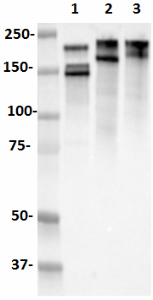
-
Western blot of HRP anti-Neurofilament H (NF-H), Nonphosphorylated antibody (clone SMI 32). Lane 1: 20 µg of human brain lysate; Lane 2: 20 µg of rat brain lysate; Lane 3: 20 µg of mouse brain lysate. The blot was incubated with 0.5 µg/ml of the primary antibody for 60 minutes at room temperature. HRP NF-H was visualized using chemiluminescence detection. -

IHC staining of HRP anti-Neurofilament H (NF-H), Nonphosphorylated antibody (clone SMI 32) on formalin-fixed paraffin-embedded human cerebellum tissue. After antigen retrieval using Retrieve-All Antigen Unmasking System 3 (Cat. No. 927801), the tissue was incubated with the primary antibody at 5.0 µg/ml for one hour at room temperature. DAB was used for detection followed by hematoxylin counterstaining and bluing solution counterstaining, according to the protocol provided.
| Cat # | Size | Price | Quantity Check Availability | Save | ||
|---|---|---|---|---|---|---|
| 801707 | 25 µg | 100€ | ||||
| 801708 | 100 µg | 249€ | ||||
Neurofilaments (NF) are approximately 10 nanometer intermediate filaments found in neurons. They are a major component of the neuronal cytoskeleton, and function primarily to provide structural support for the axon and to regulate the axon diameter. There are three major NF subunits, and the names given to these subunits are based upon the apparent molecular mass of the mammalian subunits on SDS-PAGE. The light or lowest NF (NF-L) runs at 68-70 kD. The medium or middle NF (NF-M) runs at about 145-160 kD, and the heavy or highest NF (NF-H) runs at 200-220 kD. However, the actual molecular weight of these proteins is considerably lower due to the highly charged C-terminal regions of the molecules. The level of NF gene expression correlates with the axonal diameter, which controls how fast electrical signals travel down the axon. Mutant mice with NF abnormalities have phenotypes resembling amyotrophic lateral sclerosis. NF immunostaining is common in diagnostic neuropathology. It is useful for differentiating neurons (positive for NF) from the glia (negative for NF).
Product DetailsProduct Details
- Verified Reactivity
- Human, Mouse, Rat
- Antibody Type
- Monoclonal
- Host Species
- Mouse
- Formulation
- This antibody is provided in 50% glycerol in aqueous buffered solutions with preservatives.
- Preparation
- The antibody was purified by affinity chromatography and conjugated with HRP under optimal conditions.
- Concentration
- 0.5 mg/ml
- Storage & Handling
- Upon receipt, the antibody solution should be stored undiluted at -20°C, and protected from prolonged exposure to light.
- Application
-
IHC-P - Quality tested
WB - Verified - Recommended Usage
-
Each lot of this antibody is quality control tested by immunohistochemistry staining. For immunohistochemisty of paraffin-embedded tissue, a concentration range of 5.0 to 10.0 µg/ml is suggested. For Western Blot, a concentration range of 0.5 to 1.0 µg/ml is suggested. It is recommended that the reagent be titrated for optimal performance for each application.
- Application Notes
-
Additional reported applications (for the relevant formats) include Western blotting6, immunohistochemistry4,5, immunocytochemistry1,2,3, 7, array tomography8.
Cross-reactivity to monkey tissue has been Reported in the literature, not verified in house4.
This antibody reacts with a nonphosphorylated epitope in neurofilament H of most mammalian species. The reaction is masked when the epitope is phosphorylated. The staining of isolated neurofilament preparations is greatly intensified upon dephosphorylation. Immunocytochemically, SMI 32 visualizes neuronal cell bodies, dendrites, and some thick axons in the central and peripheral nervous systems. However, thin axons are not revealed. Other cells and tissues are unreactive. The antibody distinguishes three subdivisions of the macaque precentral motor cortex. The greater size of the left versus the right superior temporal lobe was found to be due to increased axonal myelination and not due to increased number of glial cells or SMI 32-enumerated neurons, suggesting that the specialization for language in the left temporal lobe is related to increased speed of signal transmission. In cultures of murine cortex, SMI 32 labels a neuronal population with enhanced vulnerability to kainate toxicity most of which are GABAergic and reveal kainate-activated Ca2+ uptake. -
Application References
(PubMed link indicates BioLegend citation) -
- Chang Q, Martin LJ. 2011. J. Neurosci., 31:2815-27. (ICC) PubMed
- Stevens HE, et al. 2010. J. Neurosci. 30:5590-602. (ICC) PubMed
- Kiryu-Seo S, et al. 2010. J. Neurosci. 30:6658-66. (ICC) PubMed
- Redondo J, et al. 2015. Brain Pathol. 25(6):692. (IHC-P) PubMed
- Feng L, et al. 2017. eNeuro. 4(1): 0331-16.2016. (IHC-P) PubMed
- Feng L, et al. 2014. Invest Ophthalmol Vis Sci. 54(2): 1106:1117. (IHC-P) PubMed
- Theotokis, et al. 2016. J. Neuroinflammation 13(1):265 (IHC-P)
- Bennett, et al. 2015. J. Neurosci. Methods 245:25-36 (Array Tomography)
- Petzold A, et al. 2011. Brain 134:464. (WB) PubMed
- RRID
-
AB_2721607 (BioLegend Cat. No. 801707)
AB_2721607 (BioLegend Cat. No. 801708)
Antigen Details
- Structure
- Neurofilament H has an apparent molecular mass of 200-220 kD.
- Distribution
-
Tissue Distribution: CNS, peripheral nerves and glandular cells of the prostate
Cellular Distribution: cytoskeleton, nucleus, cytosol, and mitochondrion - Function
- NF-H Neurofilaments are the major components of the neuronal cytoskeleton. They provide axonal support and regulate axon diameter. Phosphorylation of NF-H results in the formation of interfilament cross bridges that are important in the maintenance of axonal caliber.
- Ligand/Receptor
- Phosphorylation seems to play a major role in the functioning of the larger neurofilament polypeptides (NF-M and NF-H), the levels of phosphorylation result in changes to the neurofilament function.
- Cell Type
- Mature Neurons
- Biology Area
- Cell Biology, Neuroscience, Neuroscience Cell Markers
- Molecular Family
- Intermediate Filaments, Phospho-Proteins
- Antigen References
-
1. Turner M, et al. 2015. J Neuroimmunol. 285:4. PubMed
2. Pagliarini V, et al. 2015. J. Cell Biol. 211:77. PubMed
3. Petzold A, et al. 2011. Brain. 134. (WB) PubMed
4. Yuan A, et al. 2016. Brain Res Bull. 126(3):334.
5. Parlakian A, et al. 2016. Rev Neurol. 172(10):607.
6. Li D, et al. 2016. Front Aging Neurosci. 8:290.
7. Costa J, et al. 2016. Clin Chim Acta. 455:7.
8. Lad SP, et al. 2010. J Stroke Cerebrovasc Dis. 21(1):30. - Gene ID
- 4744 View all products for this Gene ID
- UniProt
- View information about Neurofilament H on UniProt.org
Related Pages & Pathways
Pages
Related FAQs
Other Formats
View All Neurofilament H (NF-H), Nonphosphorylated Reagents Request Custom Conjugation| Description | Clone | Applications |
|---|---|---|
| Purified anti-Neurofilament H (NF-H), Nonphosphorylated | SMI 32 | IHC-P,WB,Array Tomography,ICC,SB |
| HRP anti-Neurofilament H (NF-H), Nonphosphorylated | SMI 32 | IHC-P,WB |
| Alexa Fluor® 488 anti-Neurofilament H (NF-H), Nonphosphorylated | SMI 32 | IHC-P |
| Alexa Fluor® 594 anti-Neurofilament H (NF-H), Nonphosphorylated | SMI 32 | IHC-P,ICC,IHC-F |
| Alexa Fluor® 647 anti-Neurofilament H, Nonphosphorylated | SMI 32 | IHC-P |
| Spark YG™ 570 anti-Neurofilament H (NF-H), Nonphosphorylated | SMI 32 | IHC-P,IHC-F |
Customers Also Purchased
Compare Data Across All Formats
This data display is provided for general comparisons between formats.
Your actual data may vary due to variations in samples, target cells, instruments and their settings, staining conditions, and other factors.
If you need assistance with selecting the best format contact our expert technical support team.
-
Purified anti-Neurofilament H (NF-H), Nonphosphorylated

IHC staining of purified anti-Neurofilament H (NF-H), Nonpho... 
Immunofluorescence staining of anti-Neurofilament H (NF-H), ... 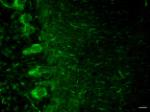
IHC-Fluorescence staining of Formalin Fixed Paraffin Embedde... 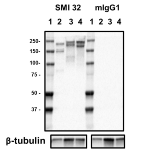
Western blot of purified anti-Neurofilament H (NF-H), Nonpho... -
HRP anti-Neurofilament H (NF-H), Nonphosphorylated
Western blot of HRP anti-Neurofilament H (NF-H), Nonphosphor... 
IHC staining of HRP anti-Neurofilament H (NF-H), Nonphosphor... -
Alexa Fluor® 488 anti-Neurofilament H (NF-H), Nonphosphorylated
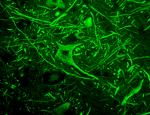
IHC staining of Alexa Fluor® 488 anti-Neurofilament H (NF-H)... -
Alexa Fluor® 594 anti-Neurofilament H (NF-H), Nonphosphorylated
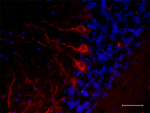
IHC staining of Alexa Fluor® 594 anti-Neurofilament H (NF-H)... 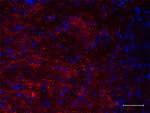
IHC staining of Alexa Fluor® 594 anti-Neurofilament H (NF-H)... 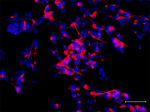
ICC staining of Alexa Fluor® 594 anti-Neurofilament H (NF-H)... -
Alexa Fluor® 647 anti-Neurofilament H, Nonphosphorylated

IHC staining of Alexa Fluor® 647 anti-Neurofilament H (NF-H)... 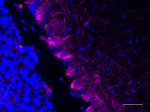
IHC staining of Alexa Fluor® 647 anti-Neurofilament H (NF-H)... 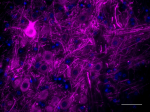
IHC staining of Alexa Fluor® 647 anti-Neurofilament H (NF-H)... 
IHC staining of Alexa Fluor° 647 anti-Neurofilament H (NF-H)... -
Spark YG™ 570 anti-Neurofilament H (NF-H), Nonphosphorylated

IHC staining of Spark YG™ 570 anti-Neurofilament H (NF-H), N... 
IHC staining of Spark YG™ 570 anti-Neurofilament H (NF-H), N... 
IHC staining of Spark YG™ 570 anti-Neurofilament H (NF-H), N...
 Login / Register
Login / Register 







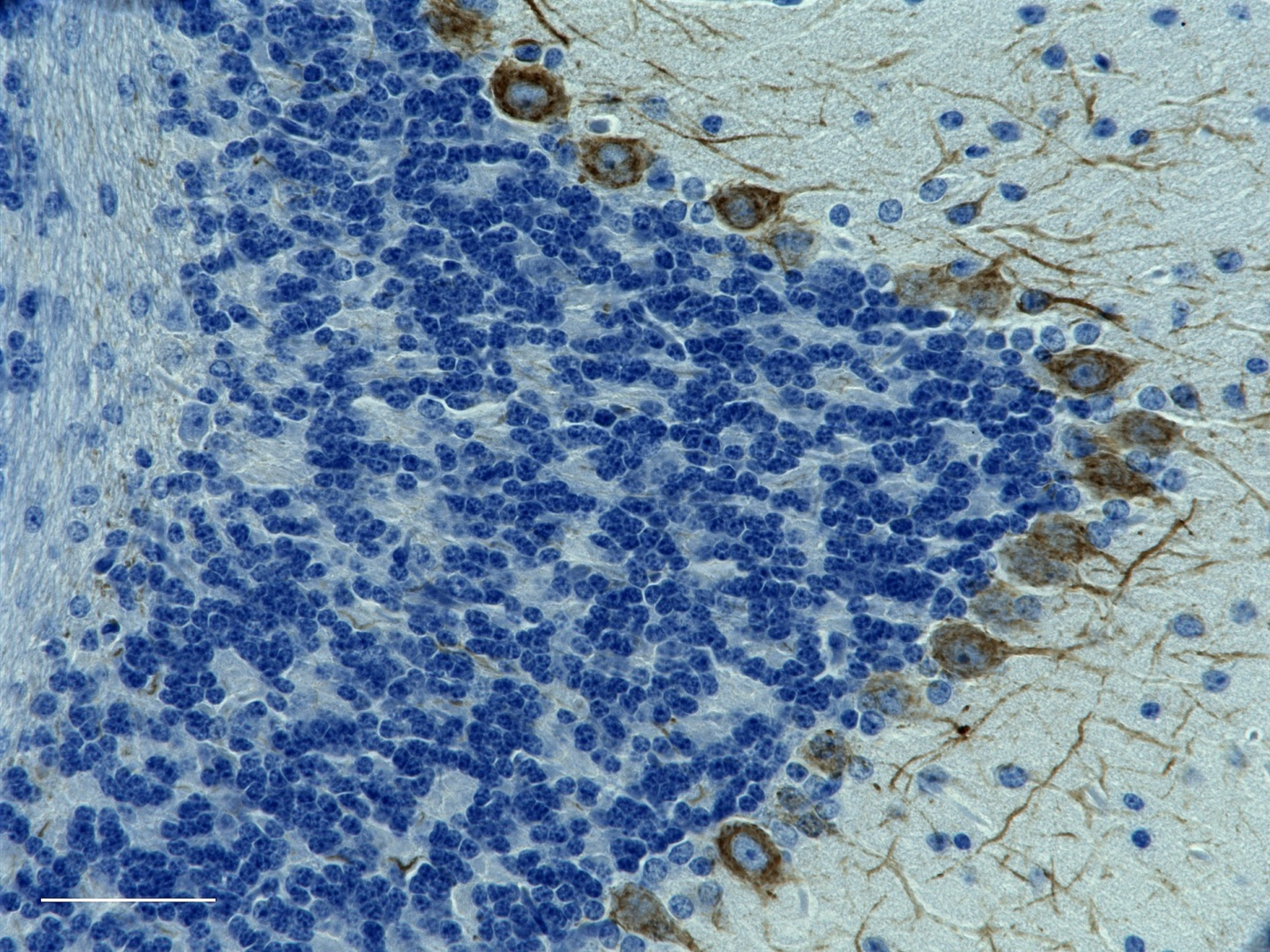
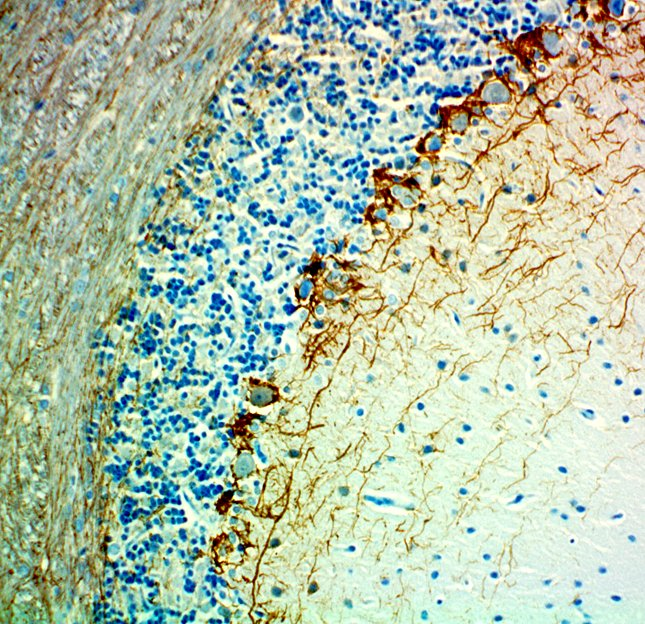
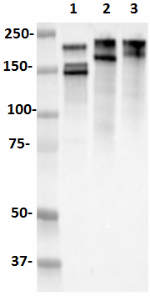



Follow Us